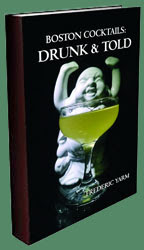3/4 oz Carpano Antica Sweet Vermouth
1 dash Fee's Whiskey Barrel Bitters
1 dash Angostura Bitters
1/2 oz Cardamom Simple Syrup
(b) 1/4 oz Green Chartreuse
Lemon Twist
Stir ingredients in (a) with ice. Add Chartreuse to rocks glass and ignite. Twist the lemon rind over the fire and drop in to caramelize. Douse the flame after 15 seconds by straining (a) over the top of (b). Serve, but let rocks glass cool before drinking.
For one of my cocktails at Drink on Sunday night, John Gertsen made me his variation on the Star Cocktail that he dubbed the Supernova. The Star Cocktail first appeared in George Kappeler's Modern American Drinks in 1895. The recipe is as follows:
Star CocktailGertsen's variation kept the basic gist of the Star Cocktail but changed the nonpotable bitters, brandy to vermouth ratio, and syrup type. However, the major change was the green Chartreuse which altered the flavor greatly, and indeed, the flame certainly added to the showmanship aspect immensely. In the drink, the Chartreuse flavors mingled with the Carpano Antica vermouth and the bitters quite nicely, and the flamed lemon twist added a slight burnt caramel nose. All of these flavors were riding on top of an orange bitters-less Marconi Wireless base. Andrea commented that the Supernova tasted "candied but not cloying", and I would have to agree that the balance of this drink was right on the money.
1 1/2 oz Apple Brandy
1 1/2 oz Sweet Vermouth
3 dashes Peychaud's or Angostura Bitters
2 dashes Gomme Syrup
Stir with ice and strain into a cocktail glass. Garnish with a lemon twist.




 1/2 oz Gin (No. 209)
1/2 oz Gin (No. 209) 2 oz Lunazul Tequila
2 oz Lunazul Tequila


 3/4 oz. gin (Beefeater)
3/4 oz. gin (Beefeater)
 For ginger wine recipes, I found a few on the Stone's website as well as CocktaiDB and I picked one from each. The first one we made was from the cocktail database under the ingredient "ginger wine" called the Commonweal Cocktail. The Stone's website said that their product mixes well with whiskey so I went with this recipe, for it uses blended Scotch, over some of the other recipes.
For ginger wine recipes, I found a few on the Stone's website as well as CocktaiDB and I picked one from each. The first one we made was from the cocktail database under the ingredient "ginger wine" called the Commonweal Cocktail. The Stone's website said that their product mixes well with whiskey so I went with this recipe, for it uses blended Scotch, over some of the other recipes. For our next cocktail, we went with one off the Stone's site that had a bigger swig of ginger wine in it to make a more pronounced ginger-flavored cocktail. The one we chose was a gin-based tall drink, the Gamble.
For our next cocktail, we went with one off the Stone's site that had a bigger swig of ginger wine in it to make a more pronounced ginger-flavored cocktail. The one we chose was a gin-based tall drink, the Gamble. 1 oz Dry Gin (Beefeater)
1 oz Dry Gin (Beefeater)

 however, since Drink does not have a bottle Gamel Dansk bitter liqueur, John made him their flavor-approximation substitution. It was a drink that he had been working on with Ben Sandrof that, like the Don's Little Bitter and the
however, since Drink does not have a bottle Gamel Dansk bitter liqueur, John made him their flavor-approximation substitution. It was a drink that he had been working on with Ben Sandrof that, like the Don's Little Bitter and the 

 3/4 oz Pisco (Don Cesar)
3/4 oz Pisco (Don Cesar) 1/2 oz Lime Juice
1/2 oz Lime Juice The 2017 collection of 855 drink recipes, bartender tributes, and essays on hospitality from CocktailVirgin's Frederic Yarm. Available at
The 2017 collection of 855 drink recipes, bartender tributes, and essays on hospitality from CocktailVirgin's Frederic Yarm. Available at  The 2012 collection of 505 drink recipes, techniques, and Boston bar recommendations from Frederic Yarm. Available at
The 2012 collection of 505 drink recipes, techniques, and Boston bar recommendations from Frederic Yarm. Available at 



